
Concept explainers
(a)
The work done in the first 0.100 m by plotting a graph between F and x.
Answer to Problem 37QAP
The work done in the first 0.100 m is 0.812 J.
Explanation of Solution
Given:
The values of x and F.
| x (m) | F (N) |
| 0.0000 | 0.00 |
| 0.0100 | 2.00 |
| 0.0200 | 4.00 |
| 0.0300 | 6.00 |
| 0.0400 | 8.00 |
| 0.0500 | 10.00 |
| 0.0600 | 10.50 |
| 0.0700 | 11.00 |
| 0.0800 | 11.50 |
| 0.0900 | 12.00 |
| 0.1000 | 12.48 |
| 0.1100 | 12.48 |
| 0.1200 | 12.48 |
| 0.1300 | 12.60 |
| 0.1400 | 12.60 |
| 0.1500 | 12.70 |
| 0.1600 | 12.70 |
| 0.1700 | 12.60 |
| 0.1800 | 12.50 |
| 0.1900 | 12.50 |
| 0.2000 | 12.50 |
| 0.2100 | 12.48 |
| 0.2200 | 9.36 |
| 0.2300 | 6.24 |
| 0.2400 | 3.12 |
| 0.2500 | 0.00 |
Formula used:
Using an excel sheet, a graph is plotted between F and x and the work done is calculated by determining the area under the curve for the displacement under consideration.
Calculation:
Enter the values of x and F in an excel sheet and plot a graph as shown below.
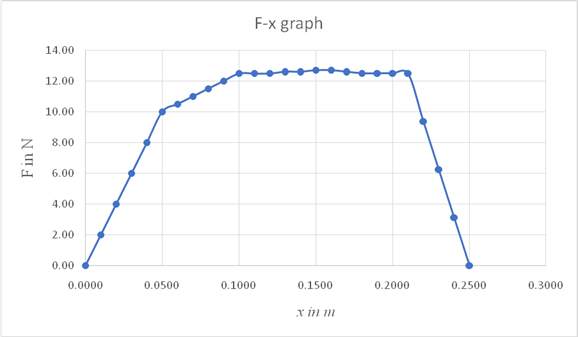
For the displacement of 0.1 s, calculate the area under the curve.
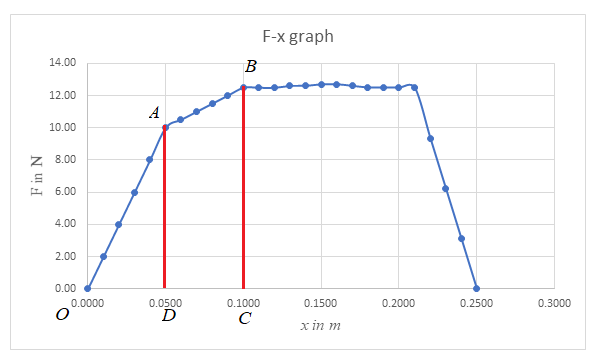
The work done during the displacement of 0.1 s is equal to area OABC.
Calculate the area of the figure OABC.
Substitute the values of the variables from the graph in the above equation.
Conclusion:
Thus, the work done in the first 0.100 m is 0.812 J.
(b)
The work done in the first 0.200 m by plotting a graph between F and x.
Answer to Problem 37QAP
The work done in the first 0.200 m is 2.06 J.
Explanation of Solution
Given:
The values of x and F.
| x (m) | F (N) |
| 0.0000 | 0.00 |
| 0.0100 | 2.00 |
| 0.0200 | 4.00 |
| 0.0300 | 6.00 |
| 0.0400 | 8.00 |
| 0.0500 | 10.00 |
| 0.0600 | 10.50 |
| 0.0700 | 11.00 |
| 0.0800 | 11.50 |
| 0.0900 | 12.00 |
| 0.1000 | 12.48 |
| 0.1100 | 12.48 |
| 0.1200 | 12.48 |
| 0.1300 | 12.60 |
| 0.1400 | 12.60 |
| 0.1500 | 12.70 |
| 0.1600 | 12.70 |
| 0.1700 | 12.60 |
| 0.1800 | 12.50 |
| 0.1900 | 12.50 |
| 0.2000 | 12.50 |
| 0.2100 | 12.48 |
| 0.2200 | 9.36 |
| 0.2300 | 6.24 |
| 0.2400 | 3.12 |
| 0.2500 | 0.00 |
Formula used:
Using an excel sheet, a graph is plotted between F and x and the work done is calculated by determining the area under the curve for the displacement under consideration.
Calculation:
The F-x graph is shown below:
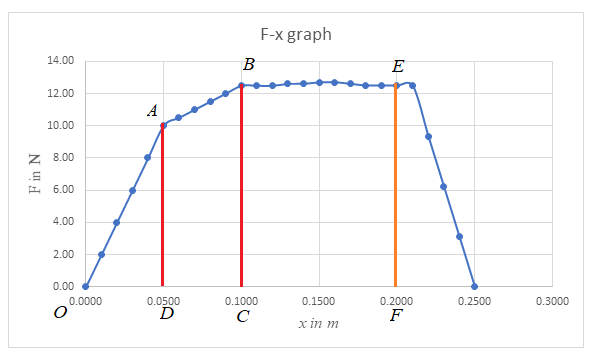
The work done during the displacement of 0.200 m is given by the area OABEF.
Assume an average value of Force as 12.50 N during the displacement from 0.100 m to 0.0200 m.
Substitute the values of the variables from the graph in the above equation.
Conclusion:
Thus, the work done in the first 0.200 m is 2.06 J.
(c)
The work done during the displacement from 0.100 m to 0.200 m by plotting a graph between F and x.
Answer to Problem 37QAP
The work done during the displacement from 0.100 m to 0.200 m is 1.25 J.
Explanation of Solution
Given:
The values of x and F.
| x (m) | F (N) |
| 0.0000 | 0.00 |
| 0.0100 | 2.00 |
| 0.0200 | 4.00 |
| 0.0300 | 6.00 |
| 0.0400 | 8.00 |
| 0.0500 | 10.00 |
| 0.0600 | 10.50 |
| 0.0700 | 11.00 |
| 0.0800 | 11.50 |
| 0.0900 | 12.00 |
| 0.1000 | 12.48 |
| 0.1100 | 12.48 |
| 0.1200 | 12.48 |
| 0.1300 | 12.60 |
| 0.1400 | 12.60 |
| 0.1500 | 12.70 |
| 0.1600 | 12.70 |
| 0.1700 | 12.60 |
| 0.1800 | 12.50 |
| 0.1900 | 12.50 |
| 0.2000 | 12.50 |
| 0.2100 | 12.48 |
| 0.2200 | 9.36 |
| 0.2300 | 6.24 |
| 0.2400 | 3.12 |
| 0.2500 | 0.00 |
Formula used:
Using an excel sheet, a graph is plotted between F and x and the work done is calculated by determining the area under the curve for the displacement under consideration.
Calculation:
The F-x graph is shown below:
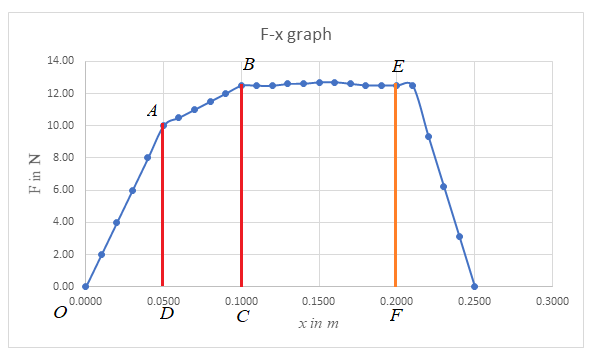
The work done during the displacement from 0.100 m to 0.200 m is given by the area BEFC.
Assume an average value of Force as 12.50 N during the displacement from 0.100 m to 0.0200 m.
Substitute the values of the variables from the graph in the above equation.
Conclusion:
Thus, the work done during the displacement from 0.100 m to 0.200 m is 1.25 J.
(d)
The work done during the entire motion
Answer to Problem 37QAP
The work done during the entire motion
Explanation of Solution
Given:
The values of x and F.
| x (m) | F (N) |
| 0.0000 | 0.00 |
| 0.0100 | 2.00 |
| 0.0200 | 4.00 |
| 0.0300 | 6.00 |
| 0.0400 | 8.00 |
| 0.0500 | 10.00 |
| 0.0600 | 10.50 |
| 0.0700 | 11.00 |
| 0.0800 | 11.50 |
| 0.0900 | 12.00 |
| 0.1000 | 12.48 |
| 0.1100 | 12.48 |
| 0.1200 | 12.48 |
| 0.1300 | 12.60 |
| 0.1400 | 12.60 |
| 0.1500 | 12.70 |
| 0.1600 | 12.70 |
| 0.1700 | 12.60 |
| 0.1800 | 12.50 |
| 0.1900 | 12.50 |
| 0.2000 | 12.50 |
| 0.2100 | 12.48 |
| 0.2200 | 9.36 |
| 0.2300 | 6.24 |
| 0.2400 | 3.12 |
| 0.2500 | 0.00 |
Formula used:
Using an excel sheet, a graph is plotted between F and x and the work done is calculated by determining the area under the curve for the displacement under consideration.
Calculation:
The F-x graph is shown below:
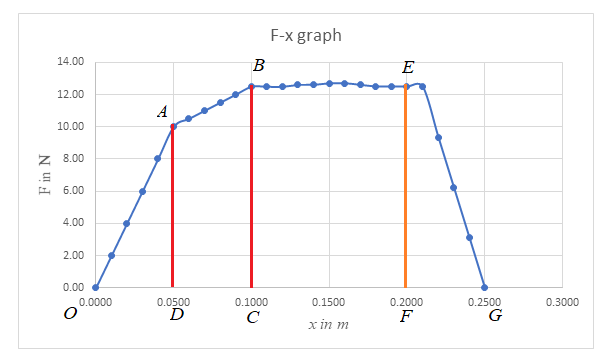
The work done during the entire displacement is given by the area OABEG.
Substitute the values of the variables from the graph in the above equation.
Conclusion:
Thus, the work done during the entire motion
Want to see more full solutions like this?
Chapter 6 Solutions
COLLEGE PHYSICS-ACHIEVE AC (1-TERM)
- Since the instruction says to use SI units with the correct sig-fig, should I only have 2 s for each trial in the Period column? Determine the theoretical period of the pendulum using the equation T= 2π √L/g using the pendulum length, L, from Data Table 2. Calculate the % error in the periods measured for each trial in Data Table 2 then recordarrow_forwardA radiography contingent are carrying out industrial radiography. A worker accidentally crossed a barrier exposing themselves for 15 seconds at a distance of 2 metres from an Ir-192 source of approximately 200 Bq worth of activity. What dose would they have received during the time they were exposed?arrow_forwardIn the following figure the circuit to the left has a switch thatat t = 0 s is switched and disconnects the battery from the circuit. The state depicted on thefigure is right after the switch, still t = 0. As the current decreases over time, the magneticflux through the circuit on the right (due to the long cable of the circuit on the left) changesand induces an EMF on the right circuit. How much power is consumed by R2 as a functionof time.The distance between the wire on the left and the closest wire on the right is r = 2.0 cm.The size of the circuit on the right is noted on the figure.arrow_forward
- singly A samply ionized helium atom is in the ground state. It absorbs energy and makes a transition to the n=7 excited state. The ion returns to wo the wavelength the ground state by emitting SIX photons ONLY. What is the of the second highest energy photon ?arrow_forwardAn electron, traveling at a speed of 5.60x10° m/s, strikes the target of an X-ray tube. Upon impart, the eletion decelerates to one-third of it's original speed, with an X-ray photon being emitted in the process. What is the wavelength of the photon? m.arrow_forwardCan you help me solve this 2 question and teach me what we use to solve thisarrow_forward
- You are working during the summer at a company that builds theme parks. The company is designing an electromagnetic propulsion system for a new roller coaster. A model of a substructure of the device appears in the figure below. Two parallel, horizontal rails extend from left to right, with one rail behind the other. A cylindrical rod rests on top of and perpendicular to the rails at their left ends. The distance between the rails is d and the length of the rails is L. The magnetic field vector B points vertically down, perpendicular to the rails. Within the rod, the current I flows out of the page, from the rail in the back toward the rail in the front. The rod is of length d = 1.00 m and mass m = 0.700 kg. The rod carries a current I = 100 A in the direction shown and rolls along the rails of length L = 20.0 m without slipping. The entire system of rod and rails is immersed in a uniform downward-directed magnetic field with magnitude B = 2.30 T. The electromagnetic force on the rod…arrow_forwardBased on the graph, explain how centripetal force is affected when the hanging mass changes. Does your graph verify the relationship in the equation r = x^i + y^j = r cos ωt I + r sin ωt^j?arrow_forwardCan you help me to solve this two questions can you teach me step by step how to solve it.arrow_forward
- Given: ruler 11.56 g, small washer 1.85 g each, large washer 24.30g each Use the data in Data Tables 4 and 5 to experimentally determine the mass of your ruler. Use one of your 2 trials with 1 small washer at 0 cm, one of your 2 trials with 2 small washers at 0 cm, and one of your 2 trials with 3 small washers at 0 cm to find three experimental values for the mass of the ruler. How do you experimentalls determine the mass?arrow_forwardCompare the 3 experimental masses of your ruler to the measured mass of your ruler (Data Table 1) by calculating the percent error for each experimental value. Which trial provided the best data for determining the mass of the ruler? Please help, I am not sure how to calculate this. Thanks!arrow_forwardPlease help, everytime I try to input the data only one point shows on the graph. Please graph unsing centripetal force, Fc, versus V E2 from Activity 1. Include a line of best fit and record the equation of the line. Thank you!arrow_forward
 University Physics Volume 1PhysicsISBN:9781938168277Author:William Moebs, Samuel J. Ling, Jeff SannyPublisher:OpenStax - Rice University
University Physics Volume 1PhysicsISBN:9781938168277Author:William Moebs, Samuel J. Ling, Jeff SannyPublisher:OpenStax - Rice University Principles of Physics: A Calculus-Based TextPhysicsISBN:9781133104261Author:Raymond A. Serway, John W. JewettPublisher:Cengage Learning
Principles of Physics: A Calculus-Based TextPhysicsISBN:9781133104261Author:Raymond A. Serway, John W. JewettPublisher:Cengage Learning Glencoe Physics: Principles and Problems, Student...PhysicsISBN:9780078807213Author:Paul W. ZitzewitzPublisher:Glencoe/McGraw-Hill
Glencoe Physics: Principles and Problems, Student...PhysicsISBN:9780078807213Author:Paul W. ZitzewitzPublisher:Glencoe/McGraw-Hill College PhysicsPhysicsISBN:9781938168000Author:Paul Peter Urone, Roger HinrichsPublisher:OpenStax College
College PhysicsPhysicsISBN:9781938168000Author:Paul Peter Urone, Roger HinrichsPublisher:OpenStax College College PhysicsPhysicsISBN:9781305952300Author:Raymond A. Serway, Chris VuillePublisher:Cengage Learning
College PhysicsPhysicsISBN:9781305952300Author:Raymond A. Serway, Chris VuillePublisher:Cengage Learning College PhysicsPhysicsISBN:9781285737027Author:Raymond A. Serway, Chris VuillePublisher:Cengage Learning
College PhysicsPhysicsISBN:9781285737027Author:Raymond A. Serway, Chris VuillePublisher:Cengage Learning





